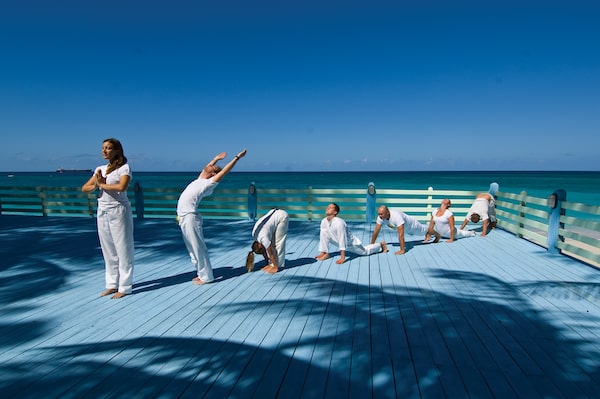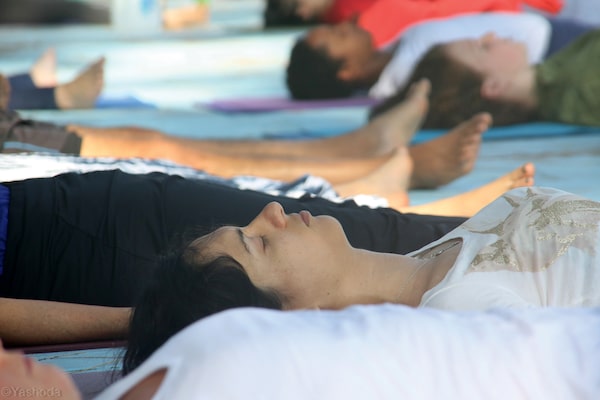
Visitors to the Sivananda Ashram on Paradise Island participate in a Sun Salutation yoga class.Sivananda Ashram
Failed IVF. The death of a parent. Career burnout. A brutal divorce. Seems as if everyone you meet at the Sivananda Ashram on Paradise Island in the Bahamas is way over the emotional baggage allowance limit.
This is not obvious right away: No aura of despair hangs over the place. The atmosphere is actually quite the opposite, but of course such matters do come up. “Why are we here?” gets asked over and over, aloud by the swamis and silently by the guests. During dinner or a beach walk, the stories emerge, all ending in a curiously similar refrain, some variation of: “I just needed to leave. This was the best decision I’ve made in a long time.”

The ashram is located on Paradise Island, a three-minute shuttle boat from Nassau.Sivananda Ashram
The ashram does not claim to be a therapeutic facility, but it’s quietly earned a reputation among those in the know as an affordable, accessible place to recover from life’s big blows. Founded in 1967 by Swami Vishnudevananda, it’s named in honour of his guru, Swami Sivananda. The five acres the ashram sits on came by way of a grateful mother/rich British landholder – one Natalie Boswell, whose drug-addicted daughter turned her life around by following the ashram program. Or so the legend goes.
After landing in the Bahamas (just a three-hour flight from Toronto), you take a 20-minute cab ride into chaotic downtown Nassau, then a three-minute shuttle boat across the harbour to Paradise Island, where the ashram has a 99-year lease on a hypnotically beautiful parcel of land. Ten minutes down the beach looms the luxury megaresort Atlantis. That can come in handy too.
Staying at any ashram requires adjusting one’s expectations about the overall hospitality experience. Comfort and service are not top-tier here. The general vibe could be summed up as deluxe hostel, minus the partying. Except for the Bahamian cleaning staff (who commute in every morning from Nassau), most of the ashram personnel are non-professionals from all over the world, donating their work in exchange for the privilege of living on-site. The demeanour of the front desk staff is perfunctory at best and the rooms, while hygienic, have thin walls and worn, spartan furnishings.

Available accommodations include shared beachfront cabins.Sivananda Ashram
In the taxonomy of vacations, an ashram is the philosophical antithesis of an all-inclusive resort, but it’s about the same price as one. Sivananda’s Yoga Vacation Program includes accommodation – which ranges from tent huts (your own or theirs), shared beachfront cabins (they can assign you a roommate of the same gender) or private rooms in the main lodge – two large lacto-vegetarian meals, two challenging yoga classes (each two hours long) and two glorious satsangs per day.
Satsang means “in the company of the highest truth” in Sanskrit and that turns out not to be as hyperbolic as it sounds. The swamis – basically Hindu monks – really hit you with the deep thoughts when you are tired and vulnerable. At 6 a.m. each morning and 8 p.m. each night, guests gather in the garden temple, a sort of open-air palapa, for 30 minutes of silent meditation, followed by mantra chanting and a talk, often about happiness. This is where the most uncomfortable, most exciting parts of the stay happen. These talks force you to confront the content of your thought patterns, an exercise that can be as challenging as regular psychotherapy. The only difference is you don’t have to share with the group (hallelujah).

Each day includes two satsangs – guided meditations led by a swami.Sivananda Ashram
“Happiness is the very essence of life itself,” began the talk one morning. “It is our birthright. But we put conditions on our happiness: If I had a different job, I would be happy. If it was sunny today, I would be happy. If I lost 20 pounds, I would be happy. What if we allowed ourselves to be happy in every condition? That would mean self-realization, which is God-realization. Can you allow yourself to be happy even when conditions are not ‘perfect?’ Because the happiness is always there.”
The schedule never varies and is repeatedly described as “mandatory,” but no one is policing your attendance at anything. You are free to find yourself. Or stay lost. And unlike most all-inclusives, it’s a haven for solo travellers: By my estimate, 85 per cent of guests were on their own (many were repeat guests). Communal dining, washrooms and sitting areas make interactions frequent and natural, leading to easy, elastic travel friendships.

A day at the ashram includes two challenging two-hour yoga classes.Sivananda Ashram
From 11 a.m. to 4 p.m. every day, do as you please. You can cry in your tent or room as much as you need to, then go for a swim at the gorgeous and mercifully deserted beach, or stroll down to Atlantis for a sinful Starbucks. Stimulants including caffeine, tobacco and alcohol are not permitted at the ashram.
Neither are garlic or onions, which overexcite the mind, according to ancient Vedic texts. Or mushrooms, because they don’t directly photosynthesize light and it’s best to eat only things that do (let’s not get into it). The generous meals are freshly prepared by a large crew of volunteers under the supervision of a real chef, but you can find more inspired vegetarian menus at restaurants in your home city. If you came to dine, you’re in the wrong place.

The ashram was founded in 1967 by Swami Vishnudevananda, and named in honour of his guru, Swami Sivananda.Sivananda Ashram
You can also take the hourly shuttle boat into town and explore Nassau’s myriad indulgences. Some of my instant friends went on day trips to other islands (the Bahamas has a mere 700), and some hiked on the sand past Atlantis for the typical jet ski/parasailing/horseback rentals ubiquitous to tropical getaways around the globe. Back at the ashram, you can also get a massage, have your astrology chart read or take a wellness workshop. I mostly read and napped on the beach (my standard healing modalities).
But it’s by following the set program that you get stronger. No one’s asking you to fall in love with yoga or accept the existence of mystical energies or convert to Hinduism. Simply show up and do as instructed (what a relief) when you feel like it, and by the third day you may notice yourself humming absently in the shower.
You may, miraculously, start to believe the gentle Sivananda brainwashing: Thou art divine. Now live up to it.
Sivananda Yoga Retreat, Paradise Island, Bahamas; Tent huts from US$119/night, rooms from US$167 a night, sivanandabahamas.org.
How to dress at an ashram
Leave your Lulus and shellac pedicure behind – they’ll be out of place here. Drop-crotch pants, voluminous pashminas, tie-dye anything and crocheted sweaters are big. As with most spiritual communities, modesty is a must: Bare shoulders are not permitted in the temples and walking around the grounds in your swimsuit is considered rude, so bring a cover-up. For yoga, practice in a t-shirt and loose cotton pants. You won’t be needing your mascara or blow dryer either. Among other things, this is a vacation from vanity.
Live your best. We have a daily Life & Arts newsletter, providing you with our latest stories on health, travel, food and culture. Sign up today.